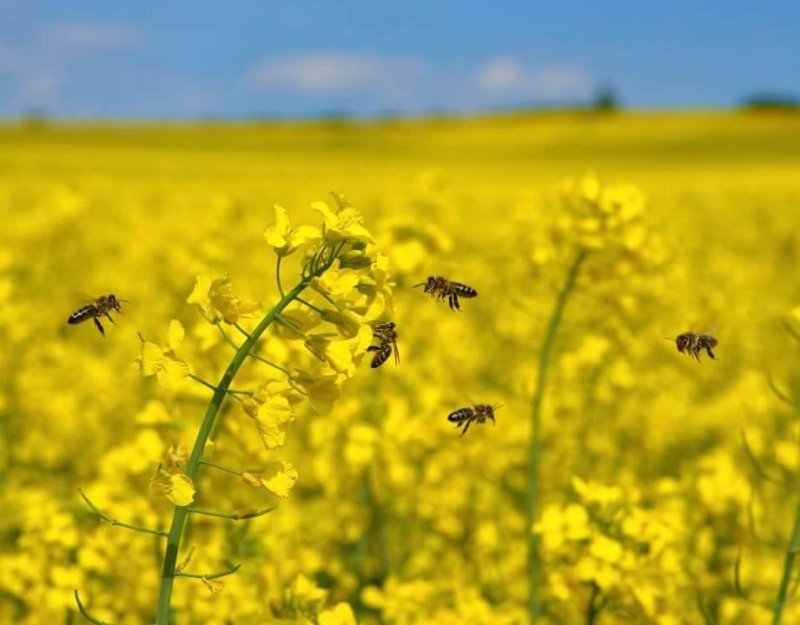The “target” is usually an ideologically disfavored industry or its products, such as nuclear power, genetic engineering, or pesticides. The result is flawed public policy choices and the ever-deepening corruption of the scientific enterprise.
[Editor’s note: This is part one of a three-part series on pollinator health and pesticides.]
Take the Great Bee Hoax, for example. If you’re still relying on the mainstream and social media for your information, you probably believe that honeybee populations are crashing worldwide, that without bees to pollinate our crops we’ll all soon starve, and that we’re in this sorry state because evil pesticide companies are reaping huge profits and despoiling the environment, while crony regulators look the other way.
At least, this is what Senate Minority Leader Chuck Schumer seems to believe. When the Agriculture Department recently suspended its annual census of U.S. honeybee hives due to budget cuts (a decision that was soon reversed), the Democratic senator from New York rose in high dudgeon claiming — what else? — collusion.
“Schumer demands USDA continue counting honeybees as populations plummet,” headlined a newspaper account of one of Schumer’s numerous statements on the subject. Suggesting that “corruption may be afoot,” he explained: “There’s great speculation that this [falling bee populations] is done by pesticides. … Maybe the pesticides industry went to the USDA and got them to quietly kill the survey.”
If so, it would have been an odd strategy, because the USDA’s beehive census has been one of the main sources of evidence that refutes alarmist claims of honeybee declines. According to the USDA count, honeybee populations, far from “plummeting,” have actually risen by about 150,000 hives in the last 20 years. Most foreign governments keep official counts of their bees, and bee populations are rising abroad, too.
The following graphs, compiled from official government and international organization statistics (here, here, and here), show honeybee colony statistics worldwide, continent-by-continent, from 1995 to the present. I chose the mid-1990s as a starting date, because that’s when state-of-the-art neonicotinoid pesticides (“neonics,” for short) — which activists claim are responsible for the “bee-pocalypse” — first came on the market.
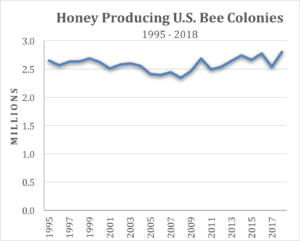
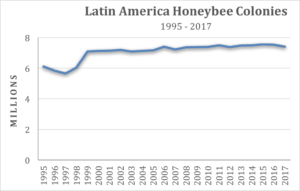
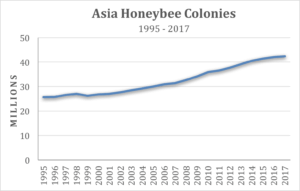

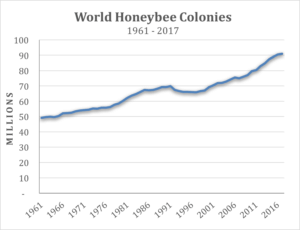
No “plummeting” anywhere to be found. Which raises an important question: If honeybee populations aren’t in trouble — anywhere — in spite of the insistent repetition that they are, where did the popular wisdom about an impending “bee-pocalypse” originate?
First, a reminder about the way science is supposed to operate: A researcher develops a testable hypothesis, for example about some cause-and-effect relationship, and then designs experiments to try to disprove it. Results of the experiment that fail to disprove the hypothesis tend to confirm it — but the confirmation is always only tentative, pending replication or new data and findings.
Now, here’s how what l call the Pseudo-Scientific Method works. If your goal is to cause a certain product to fall into disfavor, for example, first perform or sponsor experiments to get the desired, but inaccurate, results, using shoddy methodology and, if necessary, drawing conclusions not supported by the data. It doesn’t matter if the research paper is rejected by legitimate, peer-reviewed journals, because you can then submit to a predatory journal that will publish it regardless of its scientific validity (in return for a large fee). Then, organize a big media and social media blitz touting the “research,” being sure to include scary pictures or figures, and get friendly journalists and your Twitter echo-chamber to trumpet the conclusions.
With some expertise in search engine optimization, the internet becomes your indispensable ally, helping junk science sway public opinion, and even public policy. We’re seeing that in public concerns about various chemicals and modern genetic engineering applied to agriculture, for example.
That gets us to the supposed scourge of the bee world — the class of pesticides called neonicotinoids (“neonics,” for short). Nicotine is a potent natural insecticide used in organic agriculture, and synthetic neonics replaced far more harmful organophosphate insecticides three decades ago. The most widely used pesticides in much of the world, neonics are highly regarded by farmers for their safety and efficacy.
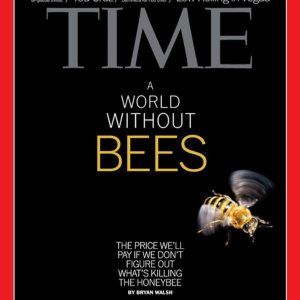
The Pseudo-Scientific Method was mobilized to create the “bee-pocalypse” narrative about honeybees over the past six years. An early, memorable landmark was the Time magazine cover story of Aug. 19, 2013, “A World Without Bees?” It shows the power of activists and a few rogue scientists, abetted by feckless magazine editors who uncritically parroted the latest alarmist studies’ claims without even bothering to check them against readily available facts.
The Zealots Go To Work
So how did all this bee anxiety get started? Well, it began with antagonism to neonics among some anti-pesticide zealots and activist scientists — with more than a little assistance and encouragement from the organic agriculture industry, which is threatened by any advances in conventional agriculture that boost its yield advantage over organic.
Neonic pesticides, which have become widely used and hailed as a major environmental and safety innovation since their introduction in the 1990s, are unlikely villains. They are:
- Highly effective in controlling crop pests and, hence, improving yields
- Benign to the environment, since they’re mainly applied as seed-treatments targeted to individual plants, dramatically reducing the need for foliar spraying
- Safer for non-target species, such as bees, since they control only pests that feed on the neonic-treated crops
- Vastly safer for other animals — especially for the human farm workers who apply them — than the old classes of pesticides they supplanted
These points are rarely, if ever, mentioned in coverage by the mainstream media. If your purpose is to demonize something in the public’s mind, you don’t want to put the issue in context. As Saul Alinsky laid out in his 1971 activist handbook, “Rules for Radicals,” first you pick an enemy, then you isolate and vilify it. And you never let up the din of negative propaganda.
Enter the honeybee and its vicissitudes. The 1987 arrival in the U.S. from Asia of Varroa destructor mites, spreading and intensifying otherwise well-understood honeybee diseases, caused an almost immediate plunge in honeybee colony numbers and heightened the cost and difficulty of running a profitable honey business. (Note that this preceded by a decade the introduction of neonics.) By the mid-1990s, coincident with the arrival of neonics, the U.S. honeybee population had stabilized around 2.5 million hives, where it remains today.
In 2006, however, some beekeepers noticed a mysterious phenomenon — later dubbed “colony collapse disorder,” or CCD — which was marked by worker bees deserting seemingly healthy hives, and leaving their queen behind. CCD caused a temporary and — compared to the dramatic declines wrought by Varroa mites — relatively minor dip in bee numbers, from which they have more than recovered.
Famine Predicted
Before the presumably new CCD phenomenon could be thoroughly researched, however, anti-pesticide campaigners, abetted by activist scientists, concocted the narrative that this was a never-before seen catastrophe, created by a new and especially lethal class of pesticides. Unless neonics were banned immediately, they said, CCD would drive bees to extinction, and the loss of these critical pollinators would decimate the food supply and threaten worldwide famine.
In hindsight, this was a clear case of Winston Churchill’s aphorism, “A lie gets half way around the world before the truth has a chance to get its pants on.” Over several years after the appearance of CCD, researchers documented that the phenomenon was not new but had been around for a while — episodes were traced back to ancient Egypt, and over the centuries had recurred unpredictably in many different locales across Europe, the British Isles, North America and Australia.

Meanwhile, with headlines blaring warnings of a global catastrophe, the time was clearly ripe for university researchers to start applying for grant money to investigate the issue and for government and other “socially relevant” grant-makers to start writing the checks. Inevitably, the scientific papers followed the activist, media-leveraged narrative with an avalanche of shoddy studies. Most experiments used “caged bees” that were massively overdosed with neonics and, not surprisingly, found negative effects on the bees. Such studies have little scientific value; it’s hardly surprising, after all, that directly administering huge doses of insecticides to insects will cause adverse reactions.
The critical questions are: At what levels are bees actually exposed to neonics in the real world, and what are the effects? It’s well known that honeybee colonies that feed almost exclusively on Alberta’s massive fields of neonic-treated canola crops thrive; and the overwhelming majority of large-scale field studies that replicate real-world conditions have borne out the safety of neonic seed treatments to pollinators.
But field studies demand an expertise that most of the academics jumping on the anti-neonic bandwagon didn’t have, and they are expensive and time consuming to carry out. Laboratory forced-feeding studies on the other hand are easy, and they’re relatively cheap and quick to produce. Most important for the investigators’ purposes, they’re practically guaranteed to produce positive results (i.e. harm to bees), so they’re more likely to get published.
All of this provides a textbook case of the Pseudo-Scientific Method in operation. Incredibly, few of these academic scientists ever bothered to even do a simple Google search of the readily accessible data on honeybee populations. The scientific literature of the time became replete with references to non-existent honeybee “declines” that blindly repeated what was being reported in the media, which in turn repeated the fabricated crisis being touted by the activists. This is a perfect example of an “information cascade,” the way in which incorrect ideas gain acceptance by being parroted until eventually we assume they must be true even in the absence of persuasive evidence. Articles describing the negative effects of neonics on honeybees were cited by succeeding papers to create a massive and growing body of “evidence” in the scientific literature supporting a proposition that was fundamentally mistaken from the start.
As the postulated catastrophes become ever more expansive, as the geography expands and the number of species involved grows from thousands to millions, many of which have never even been identified, let alone studied, the hysterical claims about widespread extinctions are never actually demonstrated. But they also become ever harder to disprove. From the viewpoint of the practitioners of the Pseudo-Scientific Method, what could be better?
The scientists who glommed onto the “bee-pocalypse” narrative never bothered to go back and correct the record. As we’ll see in the next installment, they simply swapped out crises, jettisoning honeybees for claims that it was actually wild bees that were facing extinction, and then moving on to claims that all insect species will soon die out – because, of course, of neonicotinoid pesticides.
Henry I. Miller, a physician and molecular biologist, is a senior fellow at the Pacific Research Institute. He was the founding director of the FDA’s Office of Biotechnology. Follow him on Twitter @henryimiller
This article originally ran at Issues&Insights as Apocalypse Not! How Science Is Distorted To Serve The Activist Agenda and has been republished here with permission.

